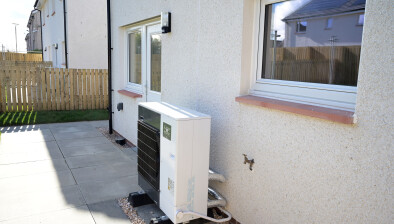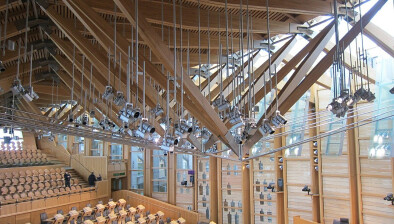Fuel poverty among Scottish households drops by 4%
 The Scottish Government has been urged to take concerted action to eliminate fuel poverty altogether after new figures revealed that the overall level amongst Scottish households is down about four percentage points in a year, equivalent to 99,000 fewer households living in fuel poverty.
The Scottish Government has been urged to take concerted action to eliminate fuel poverty altogether after new figures revealed that the overall level amongst Scottish households is down about four percentage points in a year, equivalent to 99,000 fewer households living in fuel poverty.
Statistics revealed in the latest Scottish House Condition Survey (SHCS) report for the year January to December 2016 show that 26.5% (or around 649,000) households were fuel poor and 7.5% (or 183,000 households) were living in extreme fuel poverty. This is a fall since the previous year when 748,000 households (30.7%) were fuel poor.
Housing associations have the most energy efficient stock by tenure and their overall fuel poverty level has decreased by 0.5%.
However, at 27%, there are more housing association households in fuel poverty compared to the national average (26.5%).
The Scottish Federation of Housing Associations (SFHA) said the new figures show that social landlords need more support to further improve the energy efficiency of their stock.
These statistics come as the Scottish Government consults on proposals for a new fuel poverty strategy. The publication of the new draft strategy follows a failure to meet a previous target to end fuel poverty by November 2016.
Sarah Boyack, SFHA head of public affairs, said: “While we welcome the decrease in fuel poverty levels, they still remain unacceptably high. It is particularly concerning that the percentage of housing association households in fuel poverty is higher than the overall national average, despite their housing being the most energy efficient. The figures demonstrate that social landlords need more support to further improve the energy efficiency of their stock in order to help their tenants who are on lower incomes and therefore more vulnerable to fuel poverty.
“These latest figures should act as a wake-up call, with more than a quarter of households in Scotland still in fuel poverty. We are calling on the Scottish Government to increase its funding for fuel poverty schemes to support investment in home energy efficiency, micro-renewables, and energy advice for households struggling with fuel bills.
“These figures are timely as they come a week before the Scottish Government unveils its draft budget for 2018–19 and with a consultation open on a new Fuel Poverty Strategy for Scotland. The government must take this opportunity to ramp up investment to eliminate fuel poverty once and for all.”
 The Existing Homes Alliance says next week’s Scottish Budget will be a vital test of the Scottish Government’s commitment to tackling fuel poverty.
The Existing Homes Alliance says next week’s Scottish Budget will be a vital test of the Scottish Government’s commitment to tackling fuel poverty.
The group, whose members include the Scottish Federation of Housing Associations, Citizens Advice Scotland and WWF Scotland, welcomed the new figures but it repeated its call on the Scottish Government to put adequate investment into warm homes.
Lori McElroy, chair of the Existing Homes Alliance, said: “These new figures show a very welcome fall in fuel poverty in Scotland, but they also show that more than one in four Scottish households are still fuel poor.
“That is unacceptable, particularly in rural areas where fuel poverty levels remain high at 37%. We call on the Scottish Government to do more to help people who are living in hard-to-heat housing, especially those who live off the gas grid or use electric heating.
“The last Scottish Budget set aside just £114.5 million for investment in energy efficiency – that was less than the year previously, despite energy efficiency being declared a national infrastructure priority.
“Now the Scottish Government must commit to doubling the amount of money for energy efficiency in next week’s Draft Budget. That investment will make a real difference to people’s lives, and will help the Scottish Government deliver on its promise to eradicate poor energy performance as a driver of fuel poverty.
“Investing in warm homes is money well spent. Done right, it will cut climate changing emissions, help eradicate fuel poverty, create jobs, boost the economy, and make a real difference to the health and prosperity of people across Scotland – for today and for generations to come.
“The Scottish Budget and the forthcoming Warm Homes Bill are an opportunity to make all of Scotland’s homes fit to live in. We call on Ministers and MSPs to grasp that chance.”
 Responding to the announcement, Norman Kerr, director of Energy Action Scotland (EAS), urged the government to continue efforts to make homes more energy efficient, particularly in rural areas.
Responding to the announcement, Norman Kerr, director of Energy Action Scotland (EAS), urged the government to continue efforts to make homes more energy efficient, particularly in rural areas.
He said: “I am pleased to see the number of fuel poor households decrease, which is a move in the right direction. The news that fewer people are living in cold damp homes is to be welcomed but unfortunately a return to 2007 levels of fuel poverty is far from ‘job done’.
“About a third of the drop in the annual fuel poverty level in 2016 is due to making homes in Scotland more energy efficient, while around two thirds are due to lower domestic energy prices. This underlines how important it is that the energy efficiency of homes should continue to be improved, particularly as it is unlikely that energy prices will remain relatively low as recent increases in electricity prices demonstrate.”
Mr Kerr added: “The Scottish Government is right to continue to fund programmes that aim to stop homes leaking heat and to provide modern and efficient heating however continued and higher investment in these is needed.
“The action the Scottish Government is already taking to improve the housing stock must in fact be stepped up and this is abundantly apparent in rural areas where fuel poverty levels have remained the same.
“This is particularly important at a time when Ofgem figures show that while the number of people in debt to suppliers has fallen, the average debt has increased significantly. The progress made on solving the problem of cold, damp and unaffordable to heat homes must not be lost, but can and should be built upon with increased investment and a national strategy which is capable of eradicating fuel poverty well before the proposed date of 2040.”
Sarah Beattie-Smith, senior climate and energy policy officer at WWF Scotland, said the number of households living in fuel poverty is “still unacceptably high”.
She added: “Most of the reduction is down to a fall in energy prices. If the Scottish Government is serious about insulating people from the effects of volatile energy prices, it must increase investment in energy efficiency to at least £240m this year and use next year’s Warm Homes Bill to set ambitious new targets and milestones for a transformation of Scotland’s homes over the coming decades.
“Improvements in energy efficiency have already helped to cut home energy bills by nearly £300 on average over the last decade. Investment in making our homes and buildings more energy efficient is a crucial part of the fight against climate change and will create jobs across Scotland and improve health and wellbeing.”
 Housing minister Kevin Stewart said: “The figures published today indicate almost 100,000 fewer households were in fuel poverty in 2016 compared to 2015. Almost two thirds of this reduction can be attributed to the lower price of domestic fuels during that time which is why we have continually called for the UK government to do more in response to high energy prices. The remainder of the reduction being mostly due to improvements in the energy performance of housing, which demonstrates our investment is making a difference to vulnerable households.
Housing minister Kevin Stewart said: “The figures published today indicate almost 100,000 fewer households were in fuel poverty in 2016 compared to 2015. Almost two thirds of this reduction can be attributed to the lower price of domestic fuels during that time which is why we have continually called for the UK government to do more in response to high energy prices. The remainder of the reduction being mostly due to improvements in the energy performance of housing, which demonstrates our investment is making a difference to vulnerable households.
“While this is obviously welcome news we will continue to take action across government to reduce fuel poverty in Scotland which is why we currently have a consultation on a new fuel poverty strategy - including setting new statutory targets and a revised definition of fuel poverty that will place a greater emphasis on households with lower incomes and high housing and fuel costs.”
The results from the survey show fuel poverty declining significantly for the second consecutive year
The survey shows that the long-term trend in the energy efficiency of the housing stock continues to improve, while change in the last couple of years are less evident
Proportion of the Scottish homes by grouped EPC Band under SAP 2009 and SAP 2012, 2010-2016
Levels of disrepair improve, while other housing quality indicators remain stable at 2015 levels
The full statistical publication can be accessed online.









